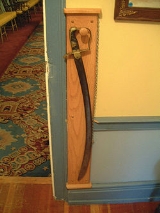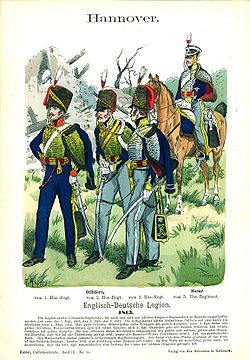
Pattern 1796 light cavalry sabre
Encyclopedia
The Pattern 1796 Light Cavalry Sabre, is a sword that was used primarily by British Light Dragoons and hussars, and King's German Legion
light cavalry during the Napoleonic Wars
. It was adopted by the Prussians (as the 1811 pattern or "Blücher
sabre") and used by Portuguese and Spanish cavalry.
into France. With the invading army was a young captain of the 2nd Dragoon Guards, serving as a brigade major
, John Gaspard Le Marchant. Le Marchant noted the lack of professional skill displayed by the horsemen and the clumsy design of the heavy, over-long swords then in use and decided to do something about it. Among many other things Le Marchant did to improve the cavalry, he designed, in collaboration with the Birmingham sword cutler Henry Osborn, a new sabre. This was adopted by the British Army as the Pattern 1796 Light Cavalry Sabre.
on each side. The sabre was lighter and easier to use than its heavy cavalry counterpart, the pattern 1796 Heavy Cavalry Sword, which had a less 'scientific' design. The hilt was of the simple 'stirrup' form with a single knucklebow, so as to be free of unnecessary weight; the intention of this was to make the sabre usable by all cavalrymen, not solely the largest and strongest. In common with the contemporary heavy cavalry sword the iron backpiece of the grip had ears which were riveted through the tang of the blade to give the hilt and blade a very secure connection.
Officers carried fighting swords very similar in form to those of the trooper version, though they tended to be lighter in weight and show evidence of higher levels of finish and workmanship. Officers stationed in India sometimes had the hilts and scabbards of their swords silvered as a protection against the high humidity of the Monsoon
season. Unlike the officers of the heavy cavalry, light cavalry officers did not have a pattern dress sword. As a result of this there were many swords made which copied elements of the 1796 pattern design but incorporated a high degree of decoration, such as blue and gilt or frost-etched blades, and gilt hilts. At their most showy, sabres with ivory grips and lion's-head pommels are not unknown. These swords were obviously primarily intended for dress rather than battle.
 The mounted swordsmanship training of the British emphasised the cut, at the face for maiming or killing, or at the arms to disable. This left masses of mutilated or disabled troops; the French, in contrast, favoured the thrust which gave cleaner kills. The sword was, however, capable of killing outright as was recorded by George Farmer of the 11th Regiment of Light Dragoons, who was involved in a skirmish on the Guadiana River in 1811, during the Peninsular War
The mounted swordsmanship training of the British emphasised the cut, at the face for maiming or killing, or at the arms to disable. This left masses of mutilated or disabled troops; the French, in contrast, favoured the thrust which gave cleaner kills. The sword was, however, capable of killing outright as was recorded by George Farmer of the 11th Regiment of Light Dragoons, who was involved in a skirmish on the Guadiana River in 1811, during the Peninsular War
:
regiments and the "flank" companies of line regiments. It was also copied by the Prussians, indeed some Imperial German troops were equipped with almost identical swords into the First World War. The Americans also adopted a pattern which was directly influenced by the British sword.
Images of an officer's fighting sword
Images of an officer's sword with blue and gilt blade
1796 Light Cavalry Sabre Drill
Anne S. K. Brown Military Collection, Brown University Library 105 British military swords, dating from the 17th century to the early 20th century from the Cyril Mazansky Collection, on permanent display at the Annmary Brown Memorial.
King's German Legion
The King's German Legion was a British Army unit of expatriate German personnel, 1803–16. The Legion achieved the distinction of being the only German force to fight without interruption against the French during the Napoleonic Wars....
light cavalry during the Napoleonic Wars
Napoleonic Wars
The Napoleonic Wars were a series of wars declared against Napoleon's French Empire by opposing coalitions that ran from 1803 to 1815. As a continuation of the wars sparked by the French Revolution of 1789, they revolutionised European armies and played out on an unprecedented scale, mainly due to...
. It was adopted by the Prussians (as the 1811 pattern or "Blücher
Gebhard Leberecht von Blücher
Gebhard Leberecht von Blücher, Fürst von Wahlstatt , Graf , later elevated to Fürst von Wahlstatt, was a Prussian Generalfeldmarschall who led his army against Napoleon I at the Battle of the Nations at Leipzig in 1813 and at the Battle of Waterloo in 1815 with the Duke of Wellington.He is...
sabre") and used by Portuguese and Spanish cavalry.
Background
During the early part of the French Revolutionary War the British Army launched an expeditionary forceExpeditionary warfare
Expeditionary warfare is used to describe the organization of a state's military to fight abroad, especially when deployed to fight away from its established bases at home or abroad. Expeditionary forces were in part the antecedent of the modern concept of Rapid Deployment Forces...
into France. With the invading army was a young captain of the 2nd Dragoon Guards, serving as a brigade major
Brigade Major
In the British Army, a Brigade Major was the Chief of Staff of a brigade. He held the rank of Major and was head of the brigade's "G - Operations and Intelligence" section directly and oversaw the two other branches, "A - Administration" and "Q - Quartermaster"...
, John Gaspard Le Marchant. Le Marchant noted the lack of professional skill displayed by the horsemen and the clumsy design of the heavy, over-long swords then in use and decided to do something about it. Among many other things Le Marchant did to improve the cavalry, he designed, in collaboration with the Birmingham sword cutler Henry Osborn, a new sabre. This was adopted by the British Army as the Pattern 1796 Light Cavalry Sabre.
Design
An eastern influence can be detected in the blade form and Le Marchant is recorded as saying that the "blades of the Turks, Mamalukes, Moors and Hungarians [were] preferable to any other". The blade profile is similar to some examples of the Indian tulwar, and expert opinion has suggested that this sword may have contributed to the design of the British sabre. The 1796 sabre had a pronounced curve, making the kind of slashing attacks used in cavalry actions decidedly easier. Even cavalrymen trained to use the thrust, as the French were, in the confusion of a melee often reverted to instinctive hacking, which the 1796 accommodated. Its blade, unlike other European sabres of the period, widened near the point. This affected balance, but made slashes far more brutal; its action in the cut has been compared to a modern bacon slicer. It is said that this vicious design prompted unofficial complaints from French officers, but this is unconfirmed. The blade of the light cavalry sabre was from 32.5 to 33 inches in length and had a single broad fullerFuller (weapon)
A fuller is a rounded or beveled groove or slot in the flat side of a blade . A fuller is often used to lighten the blade, much in the way that an I-beam shape allows a given amount of strength to be achieved with less material...
on each side. The sabre was lighter and easier to use than its heavy cavalry counterpart, the pattern 1796 Heavy Cavalry Sword, which had a less 'scientific' design. The hilt was of the simple 'stirrup' form with a single knucklebow, so as to be free of unnecessary weight; the intention of this was to make the sabre usable by all cavalrymen, not solely the largest and strongest. In common with the contemporary heavy cavalry sword the iron backpiece of the grip had ears which were riveted through the tang of the blade to give the hilt and blade a very secure connection.
Officers carried fighting swords very similar in form to those of the trooper version, though they tended to be lighter in weight and show evidence of higher levels of finish and workmanship. Officers stationed in India sometimes had the hilts and scabbards of their swords silvered as a protection against the high humidity of the Monsoon
Monsoon
Monsoon is traditionally defined as a seasonal reversing wind accompanied by corresponding changes in precipitation, but is now used to describe seasonal changes in atmospheric circulation and precipitation associated with the asymmetric heating of land and sea...
season. Unlike the officers of the heavy cavalry, light cavalry officers did not have a pattern dress sword. As a result of this there were many swords made which copied elements of the 1796 pattern design but incorporated a high degree of decoration, such as blue and gilt or frost-etched blades, and gilt hilts. At their most showy, sabres with ivory grips and lion's-head pommels are not unknown. These swords were obviously primarily intended for dress rather than battle.
Use

Peninsular War
The Peninsular War was a war between France and the allied powers of Spain, the United Kingdom, and Portugal for control of the Iberian Peninsula during the Napoleonic Wars. The war began when French and Spanish armies crossed Spain and invaded Portugal in 1807. Then, in 1808, France turned on its...
:
Fame
The blade is remembered today as one of the best of its time and has been described as the finest cutting sword ever manufactured in quantity. Outside of the cavalry swords with an identical hilt, but a lighter and shorter blade, were adopted as the officer's sword in the famous 95th Rifles, other light infantryLight infantry
Traditionally light infantry were soldiers whose job was to provide a skirmishing screen ahead of the main body of infantry, harassing and delaying the enemy advance. Light infantry was distinct from medium, heavy or line infantry. Heavy infantry were dedicated primarily to fighting in tight...
regiments and the "flank" companies of line regiments. It was also copied by the Prussians, indeed some Imperial German troops were equipped with almost identical swords into the First World War. The Americans also adopted a pattern which was directly influenced by the British sword.
External links
Images of Trooper's swordsImages of an officer's fighting sword
Images of an officer's sword with blue and gilt blade
1796 Light Cavalry Sabre Drill
Anne S. K. Brown Military Collection, Brown University Library 105 British military swords, dating from the 17th century to the early 20th century from the Cyril Mazansky Collection, on permanent display at the Annmary Brown Memorial.

